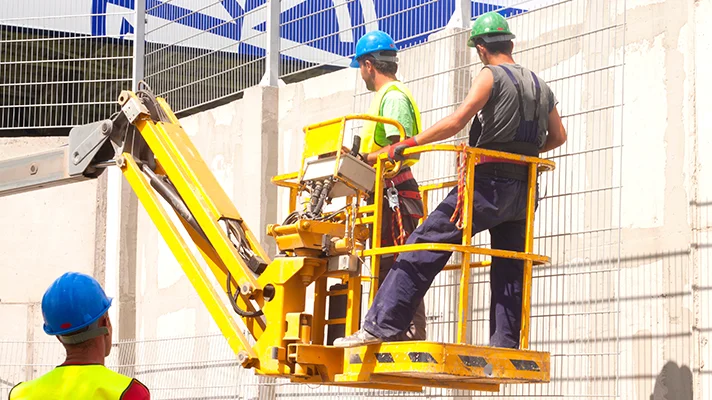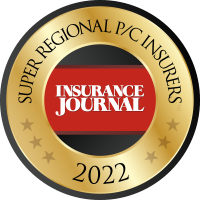Secure your future today!
Aerial Lifts and Platforms

Accidents from the operation of aerial platforms must be a priority for everyone who uses them because of the high probability for a severe injury or fatality. Aerial lift accidents are the cause of about 2% to 3% of all construction-related deaths, according the U.S. Bureau of Labor Statistics.
Lifts with articulating booms are used in a wide variety of construction jobs and account for about 70% of lift accidents. They move on multiple axels, which change the lift capacity and shift the center of gravity. This can create a higher risk for tip-over accidents. Fatalities from accidents involving all types of lifts include:
- Electrocution: 33%
- Falls: 31%
- Tip over or collapse: 22%
- Other (struck by or against objects): 14%
Electricians and people who work around power lines account for the highest number of deaths; however, this is a topic that must be properly managed by every employer regardless of whether a company operates one or many aerial lifts, or however long or short the job takes.
All employers must be familiar with equipment manufacturer specifications and OSHA standards that include: 29CFR1910.67, 29CFR1910.269(p), 29CFR1926.21, 29CFR1926.453, and 29CFR1926.502.
Equipment and Maintenance
Equipment selection and maintenance is the first step in developing an effective aerial lift policy. Although aerial lift cost increases for larger units, selecting the right size lift for the work that is anticipated is critical. The aerial lift must be able to safely reach and handle the anticipated weight for the work that is to be done.
Once it’s purchased, no equipment can be modified without written permission by the manufacturer. Inspection and maintenance for all equipment must follow manufacturer specifications. This can include inspection and maintenance of:
- Equipment controls, operation, and emergency controls.
- Safety devices in buckets like guardrails, controls, and fall arrest protection.
- Tires, wheels, and outriggers.
- Placards or signs and reporting of missing signage.
- Damaged hoses or cables.
- Battery level and hydraulic or oil levels.
Maintenance and inspections include all systems on the equipment that include the vehicle components and the components that are involved with rigging and lifting the load.
Training
Only trained employees who have been issued permits can operate aerial lifts. Training must be provided by authorized individuals who know about lift operation and limitations of the equipment. Because each lift has different specifications, operators must be trained on how to use each aerial lift that the company owns to understand its operation and limitations.
The operator is responsible for reading the aerial lift’s manual and how to operate it safely. This includes daily inspections, reporting worn or damaged parts, and wearing proper protective equipment to work near electrical lines. Operators must also be evaluated on equipment operation by a qualified individual.
Topics to cover in training include:
- Hazards and risks associated with aerial lift operation.
- Controls for the equipment, equipment safety devices, and general operations. This includes covering manufacturer requirements.
- How to set up equipment and rig loads. This includes how to determine loads, proper rigging methods, and load capacities.
- Considerations when working near other property, people, or vehicles.
- Personal protective equipment, like head, eye, and hand protection.
- Rules for work near energized electrical lines. These can include Class E insulated hard hats, voltage-rated shoes, rubber gloves, rubber sleeves, and other equipment. Insulated tools may also be required.
- Fall prevention requirements for operators, and how to properly use fall arrest equipment.
- When and what to inspect daily or periodically.
For the worksite, employers and operators must take into account how equipment will travel from one point to another and how loads will be lifted and moved into place. Employers must inspect each worksite and correct hazards before and during the operation. Hazards to look for include, but are not limited to:
- Unstable surfaces (holes, drop offs, loose dirt, slopes).
- Inadequate clearance to ceilings, electrical lines, or other overhead objects.
- Other debris or floor and ground obstructions.
- Property, people, or vehicles who are in close proximity to the aerial lift or travel path for the load.
- Other hazards like wind, ice, or severe weather.
Because worksite conditions change, operators must be able to recognize new hazards that develop and how to react to them.
Download This Article
Additional Safety Topics
Check Out All Our Products
Commercial Insurance Built for You
We offer a wide range of Commercial insurance products. Find the product that's right for you!
Specialty Insurance
Commercial Auto Insurance Workers' Compensation Insurance Manufacturing Insurance Insurance for WineriesConstruction and Contracting
General Contractor Insurance Carpenters Insurance Plumbing Insurance Excavator Insurance Electrician Insurance HVAC Business Insurance Lawn Care Business InsuranceRetail and Service
Retail Business Insurance Barber Insurance Pet Grooming Insurance Florist Insurance Bakery Insurance Photographer Insurance Beautician Insurance Coffee Shop Insurance Funeral Home Insurance Janitorial InsuranceGet Insurance for Your Car and Home
You need to protect more than just your business. Get insurance for your personal property too!
Personal Lines InsuranceWe've Got You Covered!
We offer Personal Lines Insurance in five states: Ohio, Michigan, Illinois, Indiana, and Wisconsin.
Insurance for All Types of Farms
Hastings offers a range of products specifically designed for farmers.
Farm InsuranceWe've Got You Covered!
We offer Farm Lines Insurance in five states: Ohio, Michigan, Illinois, Indiana, and Wisconsin.
Secure your future today!
Hastings Insurance Company
404 E. Woodlawn Ave.
Hastings, MI 49058
Monday-Friday
8:00 a.m. - 4:30 p.m. (EST)
(800) 442-8277
Terms of Use and Privacy Statement© Hastings Insurance Company. All rights reserved.



